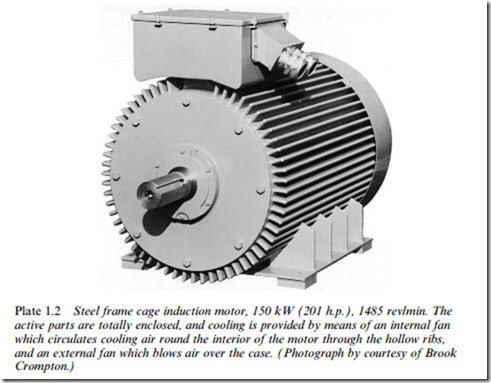GENERAL PROPERTIES OF ELECTRIC MOTORS
All electric motors are governed by the laws of electromagnetism, and are subject to essentially the same constraints imposed by the materials (copper and iron) from which they are made. We should therefore not be surprised to Wnd that at the fundamental level all motors – regardless of type – have a great deal in common.
These common properties, most of which have been touched on in this chapter, are not usually given prominence. Books tend to concentrate on the diVerences between types of motors, and manufacturers are usually interested in promoting the virtues of their particular motor at the expense of the competition. This divisive emphasis causes the under- lying unity to be obscured, leaving users with little opportunity to absorb the sort of knowledge which will equip them to make informed judgements.
The most useful ideas worth bearing in mind are therefore given below, with brief notes accompanying each. Experience indicates that users who have these basic ideas Wrmly in mind will find themselves able to understand why one motor seems better than another, and will feel much more conWdent when faced with the diYcult task of weighing the pros and cons of competing types.
Operating temperature and cooling
The cooling arrangement is the single most important factor in deter- mining the output from any given motor.
Any motor will give out more power if its electric circuit is worked harder (i.e. if the current is allowed to increase). The limiting factor is normally the allowable temperature rise of the windings, which depends on the class of insulation.
For class F insulation (the most widely used) the permissible temperature rise is 100 K, whereas for class H it is 125 K. Thus if the cooling remains the same, more output can be obtained simply by using the higher-grade insulation. Alternatively, with a given insulation the out- put can be increased if the cooling system is improved. A through- ventilated motor, for example, might give perhaps twice the output power of an otherwise identical but totally enclosed machine.
Torque per unit volume
For motors with similar cooling systems, the rated torque is approxi- mately proportional to the rotor volume, which in turn is roughly proportional to the overall motor volume.
This stems from the fact that for a given cooling arrangement, the speciWc and magnetic loadings of machines of diVerent types will be more or less the same. The torque per unit length therefore depends Wrst and foremost on the square of the diameter, so motors of roughly the same diameter and length can be expected to produce roughly the same torque.
Power per unit volume – importance of speed
Output power per unit volume is directly proportional to speed.
Low-speed motors are unattractive because they are large, and there- fore expensive. It is usually much better to use a high-speed motor with a mechanical speed reduction. For example, a direct drive motor for a portable electric screwdriver would be an absurd proposition.
Size effects – specific torque and efficiency
Large motors have a higher speciWc torque (torque per unit volume) and are more eYcient than small ones.
In large motors the speciWc electric loading is normally much higher than in small ones, and the speciWc magnetic loading is somewhat higher. These two factors combine to give the higher speciWc torque.
Very small motors are inherently very ineYcient (e.g. 1% in a wrist- watch), whereas motors of over say 100 kW have eYciencies above 95%. The reasons for this scale eVect are complex, but stem from the fact that the resistance volt-drop term can be made relatively small in large electromagnetic devices, whereas in small ones the resistance becomes the dominant term.
Efficiency and speed
The eYciency of a motor improves with speed.
For a given torque, power output rises in direct proportion to speed, while electrical losses are – broadly speaking – constant. Under these conditions, eYciency rises with speed.
Rated voltage
A motor can be provided to suit any voltage.
Within limits it is always possible to rewind a motor for a diVerent voltage without aVecting its performance. A 200 V, 10 A motor could be rewound for 100 V, 20 A simply by using half as many turns per coil of wire having twice the cross-sectional area. The total amounts of active material, and hence the performance, would be the same.
Short-term overload
Most motors can be overloaded for short periods without damage.
The continuous electric loading (i.e. the current) cannot be exceeded without damaging the insulation, but if the motor has been running with reduced current for some time, it is permissible for the current (and hence the torque) to be much greater than normal for a short period of time. The principal factors which inXuence the magnitude and duration of the permissible overload are the thermal time-constant (which governs the rate of rise of temperature) and the previous pattern of operation. Thermal time constants range from a few seconds for small motors to many minutes or even hours for large ones. Operating pat- terns are obviously very variable, so rather than rely on a particular pattern being followed, it is usual for motors to be provided with over- temperature protective devices (e.g. thermistors) which trigger an alarm and/or trip the supply if the safe temperature is exceeded.
